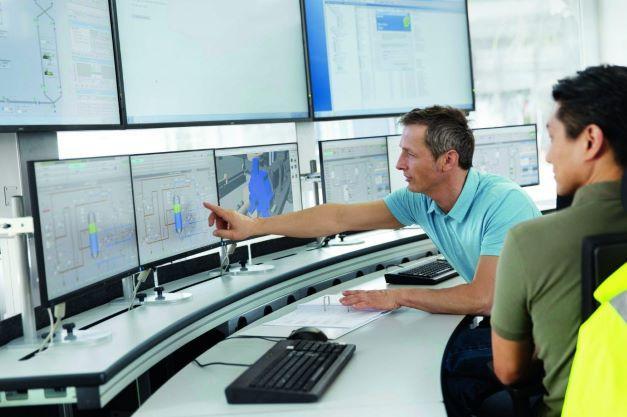Important Differences between PLC and DCS
One of the most common questions in industrial control and automation systems is “what’s the difference between a PLC and a DCS? In order to fully understand the difference between these two systems, we must look at the history of Programmable Logic Controllers (PLC) and Distributed Control Systems (DCS), and break down their internal components.
The main difference between PLC and DCS is that a PLC controls individual machines while a DCS controls multiple machines within a factory or plant. However, this is just a basic explanation. Let’s go a little deeper and examine the important differences that are less commonly known.
History of Programmable Logic Controllers
PLCs were invented to replace the older version of a control system that relied on relays and contactors in order to function. DCS, or distributed control systems, were invented to accommodate additional needs within the automation industry. They were not introduced to replace PLCs, but rather coexist with them and enhance the functionality of a plant or factory.
The need for PLCs sprung up because the old systems lacked flexibility and required an inordinate amount of time to fix issues. The outdated systems were difficult to troubleshoot due to dirty connections, loose wires and cryptic documentation. Control systems were still handled by using relay controls, which meant that entire rooms had walls covered in relays, terminal blocks and cords. Many of the issues with the relays and contactors sparked the old saying “five hours to find it, five minutes to fix it.”
People needed a much more efficient model. They needed something that could reduce machine downtime, work in an industrial environment that was notorious for its dirt, moisture and debris, and also allow for modular expansion. In 1971, Allen-Bradley created a new design called the Bulletin 1774 PLC. While other companies were designing their own prototypes and making waves, Allen-Bradely became synonymous with PLCs for their innovation. However, Richard Morely, who worked with Modicon, is generally referred to as the father of the PLC. He’s credited with designing the original ladder-logic programmable controller, and the creating ladder logic programming,

How Distributed Control Systems Evolved
Process control was still expanding in the early 1960s. The biggest change occured when the company Imperial Chemical Industries replaced their analog control system with a computer. This meant that a computer could actually perform the control tasks, instead of an analog system supervising the tasks. This concept became known as Direct Digital Control (DDC) and proved to be more cost-effective as well as more efficient. DDC languages emerged in large numbers. Because of its simplicity, it became known for its use in building automation tasks like heating and ventilation. Even today, DCS systems are rooted in the early DDC languages.
Up until the 1980s, technological advances had mainly been focused on replacing analog control systems with computers. While this was revolutionary, the next step was to create a centralized system where everything could be controlled. Midac was one of the first companies to achieve this, creating an advanced building automation system for the University of Melbourne. The system had a system with microprocessors sharing tasks and memory.
However, in the 90s with the domination of Microsoft, DCS companies learned to become more software oriented, understanding that continuing to produce some of the hardware was no longer viable—and this is still going on today.
The Main Differences Between the Two
PLCs have a fairly simple operating system. They can complete tasks fairly quickly because there are no other programs in the background demanding its attention. PLCs also tend to be quicker because they’re close to the device that they’re meant to control, such as motors and pumps. PLCs work to control a single machine; it can focus its attention on a single task and operate machine processes. This is much different than a DCS, which controls multiple machines at once in a large setting.
On top of that, PLCs tend to be more flexible and can be customized to suit a specific need, where DCS generally cannot. PLCs tend to use lower level languages. They are simple yet offer fewer functions. This includes ladder logic, function block diagram, and structured text language. The generated codes are markedly smaller compared to the codes the DCS languages create. DCS uses high-level programming languages like CFC or “continuous functioning chart” to issue its programming and monitoring. This is very different from a PLC, which uses lower level language. The downside of this is that high-level languages generate lots of codes after being compiled, which puts a strain on the CPU. This causes a delayed response to important inputs.
PLC monitoring systems differ from DCS even more because there’s no relationship between the programming and the monitoring environments. They each need their own time to be created and developed. The DCS also has a different monitoring system than the PLC. The DCS has an integrated software package in which there is a robust set of monitoring facilities. The control functions are within the programming environment, meaning the corresponding graphics will automatically be added to the HMI page. The monitoring systems function in a way that saves precious time.
DCS vs. PLC Explained
The most basic difference between a PLC and a DCS is that PLCs were designed to replace relay-based controls and analog equipment, controlling one machine. DCS, on the other hand, are used to control entire plants, buildings, or processes that are vast and interconnected. While the main difference between DCS and PLC is how they’re used and what they’re used for, there are other less obvious differences that you should be aware of if you’re interested in this world.
As a PLC technician, understanding these differences will make you stronger in your career and build up your expertise. If you want to learn more and expand your knowledge about the exciting world of PLCs, check out our PLC Technician Training Program. The program prepares students for a career as a PLC technician and is great for those who are new to PLCs or who already have experience in the field.
Comments
Education is a good place to…
Submitted by iris on Tue, 10/18/2022 - 08:19
Education is a good place to start. Our PLC program. provides a basic introduction to PLCs and focuses on the practical applications of using them in a plant or manufacturing system. This program is designed for students with little or no PLC experience and who require a safe and quick start in the fundamentals of PLC programming.
The PLC Technician II…
Submitted by iris on Wed, 03/08/2023 - 10:45
The PLC Technician II Certificate program provides an advanced study of PLCs in manufacturing including Distributed Control Systems (DCS), Supervisory Control and Data Acquisition Systems (SCADA) and advanced programming languages. The program includes PLCLogix 5000, our lab simulator based on the Studio 5000/RSLogix 5000 programming applications. It enables you to design, run, test and debug ladder logic programs and simulate the operation of real-world PLC components. You can register online at https://www.plctechnician.com/how-to-register.

I am new to plc. so how can I get knowledge?